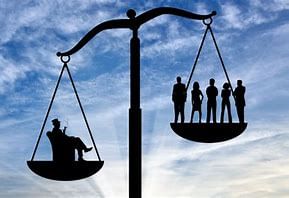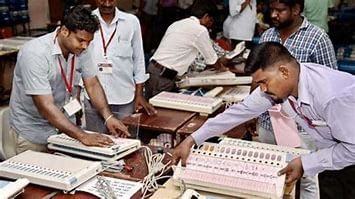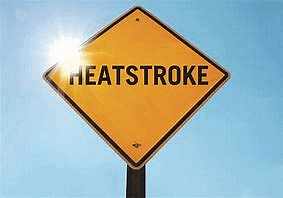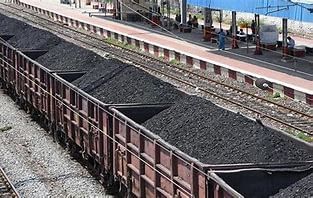UPSC Daily Current Affairs - 3rd June 2024 | Current Affairs & Hindu Analysis: Daily, Weekly & Monthly PDF Download
GS-I/Indian Society
More women join workforce, but leadership gaps remain, shows study
Source: Business Standard

Why in the news?
Although women's representation in the workforce has grown over the years,
What does the data show?
- Representation of women in the workforce has increased over the years but progress has stalled since 2022 and declined in 2024.
- The promotion of women to senior and leadership roles has stagnated in recent years.
- Sectors like healthcare, education, administrative, and support services have higher female representation in senior positions, while sectors like manufacturing, construction, oil, and gas have poor representation.
Representation of women in the overall workforce and in senior positions
- Oil, Gas, and Mining: Among the lowest representation of women in leadership roles, at around 11%.
- Construction: Very few women are represented, especially in senior roles.
- Utilities: Women face significant barriers in advancing to leadership positions.
- Wholesale: Low entry and career progression for women.
- Manufacturing: Poor representation of women across all positions, including senior roles.
- Transportation: Limited career progression opportunities for women.
- Real Estate: Few women in leadership positions, with significant entry barriers.
About the accommodation and other services
- Representation of women in senior roles within the accommodation and food services sector falls between 15% and 20%.
- This sector exhibits a moderate level of female representation compared to other industries.
- While not the highest, it surpasses sectors like oil, gas, mining, construction, utilities, wholesale, manufacturing, transportation, and real estate, where women hold just 11%-14% of leadership positions.
- The data suggests there's still room for improvement in increasing the number of women in leadership roles within the accommodation and food services sector.
Administrative and support services:
- Women hold senior positions in administrative and support services at a rate of 22% to 30%, indicating a moderate level of representation compared to other sectors.
- This sector demonstrates a higher level of female representation in leadership roles compared to industries like oil, gas, mining, construction, utilities, wholesale, manufacturing, transportation, and real estate, where women's leadership roles range from 11% to 14%.
- The education sector boasts the highest representation of women in senior positions at 30%, suggesting that sectors like administrative and support services still have room for improvement.
- Efforts to promote gender diversity and inclusion within administrative and support services should be sustained, aiming for further increases in the representation of women in leadership roles.
Way Forward
- Efforts by policymakers and business leaders are needed to tackle challenges faced by women in reaching leadership roles, focusing on "women-led development".
- Stricter enforcement of laws such as the Companies Act, 2013, which mandates women directors on company boards. Between April 2018 and December 2023, 507 companies were fined for non-compliance, with 90% being listed companies.
Mains PYQ
Micro-Finance as an anti-poverty vaccine, is aimed at asset creation and income security of the rural poor in India. Evaluate the role of the Self Help Groups in achieving the twin objectives of empowering women in rural India. (UPSC IAS/2020)
GS3/Environment
Protecting Mangroves in Tamil Nadu
Source: The Hindu

Why in news?
The International Union for Nature Conservation (IUCN) identified mangroves in coastal areas of Tamil Nadu, Sri Lanka, and Maldives as 'critically endangered' in its first global assessment of mangrove ecosystems.
Red List of Mangrove Ecosystems: Study by IUCN
- A global assessment indicates a 50% risk of mangrove ecosystem collapse, predicting significant losses by 2050.
- Consequences of inaction include the loss of carbon reserves, protection from coastal flooding, and economic impacts.
- Main threat: Sea-level rise affecting mangrove habitats with a quarter of global mangrove areas at risk of submersion in the next 50 years.
Tamil Nadu’s Conservation Efforts
- The Tamil Nadu Forest Department has effectively doubled the mangrove cover from 23 sq km in 2001 to 45 sq km in 2021.
- Notable restoration projects have been initiated in various districts with plans for further expansion under the World Bank-funded Tamil Nadu Coastal Restoration Mission.
TN-SHORE Initiative
- Launched in January 2024, the TN-SHORE initiative aims to tackle environmental issues along the coastline with substantial funding, focusing on blue carbon sequestration.
Back2Basics: Mangroves
- Mangroves are coastal trees and shrubs thriving in intertidal zones, primarily in tropical regions due to their intolerance to cold temperatures.
- Distinct features include adaptations to waterlogged soil, salt tolerance, water retention mechanisms, aerial roots for stability, and viviparity for efficient reproduction.
Mangroves in India
- India's mangrove cover constitutes a small fraction of the country's total geographical area, with significant concentrations in West Bengal, Gujarat, and the Andaman and Nicobar Islands.
- The Sundarbans, home to sundari mangroves, is the largest continuous mangrove forest globally, protected within various reserves and sanctuaries across the country.
GS3/Environment
RED LIST OF MANGROVE ECOSYSTEMS
Source: Indian Express

Why in news?
The IUCN has released a comprehensive global assessment known as the "Red List of Mangrove Ecosystems" stating that half of the world's mangrove ecosystems are in danger of collapsing.
- Mangrove ecosystems span approximately 150 thousand km2 along tropical, sub-tropical, and some warm temperate coastlines globally, covering about 15% of the world's coastlines.
- Mangrove ecosystems play a crucial role in biodiversity conservation, providing essential goods and services to local communities, and mitigating the impacts of climate change.
Key Findings of the Report:
- The report categorizes the world's mangrove ecosystems into 36 regions called provinces, evaluating the threats and risk of collapse in each region.
- More than 50% of the world's mangrove ecosystems are at risk of collapse, with nearly one in five facing severe risk.
- Approximately one-third of the world's mangrove ecosystem provinces will be severely impacted by sea-level rise, potentially submerging 25% of the global mangrove area within the next 50 years.
- The mangrove ecosystem in South India, shared with Sri Lanka and the Maldives, is labeled as "critically endangered," while those in the Bay of Bengal region (shared with Bangladesh) and the western coast (shared with Pakistan) are deemed as "least concerned."
- Climate change is identified as the primary threat to global mangrove ecosystems, affecting 33% of mangroves worldwide, followed by deforestation, development, pollution, and dam construction.
- The increasing frequency and intensity of cyclones, typhoons, hurricanes, and tropical storms are adversely affecting mangroves in specific coastal areas.
- Coastlines along various regions like the Northwest Atlantic, North Indian Ocean, Red Sea, South China Sea, and Gulf of Aden are predicted to face significant impacts, potentially resulting in the loss and submergence of substantial mangrove areas by 2050 without enhanced conservation efforts.
Status of Mangroves Cover in India:
- Mangroves are a distinct type of coastal ecosystem prevalent in tropical and subtropical regions, characterized by dense forests of salt-tolerant trees and shrubs thriving in intertidal zones.
- India accounts for about 3% of the total mangrove cover in South Asia, with approximately 40% of the world's mangrove cover located in Southeast Asia and South Asia combined.
- India's mangrove cover has expanded by 54 sq. km, representing a 1.10% increase from the previous assessment, with the current cover at 4,975 sq. km, constituting 0.15% of the country's total geographical area.
- West Bengal leads in India's mangrove cover at 42.45%, followed by Gujarat at 23.66% and the Andaman & Nicobar Islands at 12.39%, with South 24 Parganas district in West Bengal alone contributing 41.85% of the nation's mangrove cover, including the Sundarbans National Park, one of the largest mangrove forests globally.
- Gujarat has witnessed the most significant increase of 37 sq. km in mangrove cover.
GS1/Indian Society
Women often outlive men but in poorer health: what new Lancet study says
Source: Indian Express

Why in news?
New Lancet study spanning over 30 years reveals minimal advancements in narrowing gender health disparities globally.
- On Health Disparities: Women are more prone to lower back pain, depression, and headaches, while men face higher mortality rates due to road accidents, cardiovascular diseases, and COVID-19.
- On Health Burden: Women experience more years in poor health, whereas men are more susceptible to premature death from severe conditions.
- Global Analysis:Examination of disparities in the 20 primary causes of illness and death worldwide, considering all age groups and regions.
Biological Factors:
- Hormonal Differences: Fluctuations in hormones affect women's susceptibility to conditions like migraines, depression, and autoimmune diseases.
- Genetic Variations: Differences in genes contribute to varying disease susceptibility and severity between genders.
- Anatomical Variances: Physiological disparities influence the manifestation of diseases like lower back pain and reproductive disorders.
Societal and Gender Norms:
- Healthcare-Seeking: Societal norms and gender roles impact healthcare-seeking behaviors, with men less likely to seek help for mental health due to masculinity stereotypes.
- Occupational Hazards: Differences in occupational exposures lead to varying health risks, with some professions associated with higher injury rates or exposure to harmful substances.
- Socioeconomic Factors: Socioeconomic status disparities affect disease prevalence and outcomes differently for men and women.
Healthcare System Bias:
- Diagnostic Bias: Gender biases in healthcare lead to underdiagnosis or misdiagnosis in women, resulting in delayed treatment and poorer outcomes.
- Treatment Disparities: Variances in treatment approaches between genders result in women sometimes receiving less aggressive cardiovascular disease treatments or inadequate pain management.
- Research Bias: Historically, medical research primarily focused on males, leading to gaps in understanding how diseases manifest differently in women.
No Improvement in Care for Women Over Time:
- Stable Gender Gap: Despite overall health advancements, the gap between male and female health conditions remains consistent.
- Conditions Affecting Women: Health issues like lower back pain and depressive disorders show minimal improvement compared to male-dominated conditions over time.
- Reproductive Focus: Historically, global healthcare systems concentrated on women's reproductive health, neglecting other significant health concerns affecting women.
What Needs to Be Done (Way Forward):
- Better Data Collection: Governments should consistently categorize health data by sex and gender to address disparities effectively.
- Targeted Health Interventions: Develop specific interventions based on detailed sex and gender data for effective healthcare solutions.
- Increased Funding: Allocate more resources to underfunded conditions disproportionately affecting women, such as mental health.
- Addressing Healthcare Bias: Eliminate biases in healthcare to ensure women receive timely and appropriate treatment for their conditions.
Mains PYQ
Can the vicious cycle of gender inequality, poverty, and malnutrition be broken through microfinancing of women SHGs? Explain with examples. (UPSC IAS/2021)
GS3/Economy
Is Redistribution a Tool for Lowering Inequality
Source: The Hindu
Why in News?
Researchers from the Paris School of Economics have highlighted that inequality in modern India has exceeded that of the colonial period. This article aims to explore the concept of inequality and the potential of redistribution policies in mitigating it.
Argument For and Against Inequality
- Some researchers argue that a certain level of inequality can be advantageous as it motivates entrepreneurs to establish businesses, thereby enhancing employment opportunities and overall well-being.
- On the contrary, opponents of inequality contend that it can have detrimental economic and political consequences.
- For instance, it can impede democratic processes and lead to the consolidation of monopoly power among capitalists, disadvantaging labor.
- To address this issue, proponents recommend the implementation of wealth taxes and distribution policies.
Business Monopoly and Inequality
- Monopolies, by virtue of their dominance in specific markets, possess the ability to dictate prices for their products, rather than being subject to market forces.
- This practice, known as "greedflation," involves businesses raising prices to bolster profit margins. Consequently, the existence of monopolies can drive down real wages, fostering economic inequality within society.
Condition Favorable for Workers - Role of 'Multiplier' Effect
- When companies opt to establish new facilities, wages are disbursed to laborers involved in their construction.
- These wages are subsequently spent on consumer goods, thereby augmenting the income of sellers and triggering a chain reaction of increased spending.
- This cascading effect, known as the 'multiplier' effect, results in a greater overall income rise for workers and sellers than the initial investment amount.
Companies Exercise Monopoly
- Under a monopoly, real wages tend to be lower, limiting workers' purchasing power.
- Despite this, companies can maintain profits even with reduced sales volumes due to higher profit margins.
- Consequently, investments have a diminished impact on growth under monopoly conditions, as company profits remain constant while worker incomes decline.
Can the Consumption of the Rich Boost Growth?
- Wealthier individuals tend to spend a smaller portion of their income compared to lower-income earners.
- As a result, in an unequal economy, where the majority possesses less disposable income, overall economic growth can be hindered. While some argue that high taxes on the wealthy may discourage entrepreneurship and investment, others suggest that taxing billionaires and providing basic income to the less privileged could stimulate entrepreneurship and foster new business ventures.
Conclusion
Redistribution alone cannot single-handedly address inequality, and excessively high tax rates may harm an economy. However, when combined with other strategic interventions, redistribution measures can effectively reduce inequality.
GS1/Geography
INDIA METEOROLOGICAL DEPARTMENT (IMD)
Source: Indian Express

Why in news?
When the weather station in Mungeshpur, Delhi, reported a record-breaking high temperature of 52.9 degrees Celsius on May 29, the India Meteorological Department (IMD) clarified that this reading was due to sensor malfunction.
Key Points about IMD
- Established in 1875 as the National Meteorological Service of India.
- Headquartered in Delhi with numerous observation stations across India and Antarctica.
- Engages in meteorology, seismology, and related subjects.
- Provides services such as rainfall information, monsoon updates, cyclone alerts, agromet advisory, climate services, and more.
- Plays a crucial role in offering weather forecasts and warnings essential for sectors like agriculture, aviation, and disaster management.
- Conducts specialized forecasts and research in meteorology and related fields.
Additional Information - History of Meteorology in India
- The roots of meteorology in India can be traced back to ancient times, with early writings discussing cloud formation, rain processes, and seasonal cycles. Notably, historical works like Brihatsamhita and Arthashastra provide evidence of advanced atmospheric knowledge.
- Significant advancements in meteorology occurred in the 17th century, marked by scientific breakthroughs like the thermometer and barometer. This era also saw the publication of works by scientists like Edmond Halley, who studied the Indian summer monsoon.
- India boasts some of the world's oldest meteorological observatories, with establishments by the British East India Company and scientific promotion by institutions like the Asiatic Society of Bengal. The formal beginning of meteorological services in India dates back to 1875 with the establishment of the India Meteorological Department.
GS2/Polity
Counting the postal ballot
Source: MSN

Why in news?
Ahead of the vote counting for the Lok Sabha elections on June 4, the INDIA bloc requested the Election Commission to instruct Returning Officers to finish counting postal ballots before starting the EVM vote count.
Postal Voting
- Postal voting, also known as absentee voting, is a method of voting in which electors cast their ballots by mail rather than in person at a polling station.
- This method is particularly useful for individuals who are unable to vote in person due to various reasons, such as being away from their home constituency, having a disability, or being engaged in essential services on election day.
Eligibility
- Service voters: Members of the armed forces, paramilitary forces, and other government employees deployed on election duty far from their home constituencies.
- Absentee voters: Individuals who are unable to vote in person due to reasons such as being away from their home constituency for work, illness, or disability.
- Electors on election duty: Government officials and polling staff who are assigned duties at polling stations other than their own.
- Electors under preventive detention: Individuals who are detained under preventive custody orders during the election period.
Eligibility during Covid pandemic
- During the Covid-19 pandemic, the facility was extended to those infected or suspected to be infected with the coronavirus, starting with the Bihar Assembly elections in 2020.
- The EC recommended extending the postal ballot facility to those above 65 years of age, but eventually decided not to include this age group due to practical constraints. Subsequent amendments were made to adjust the eligibility age for senior citizens.
Background: counting the postal ballot
- Prior to the 2019 LS elections, postal ballots were counted before EVM counting began.
- Guidelines were adjusted post-2019 elections due to increased postal ballot numbers stemming from new systems like ETPBS and VVPAT verifications.
- The revised rules allow for simultaneous EVM and postal ballot counting, with specific provisions for re-verification of invalid postal ballots in close contests.
Postal ballot - statistics
- During the 2019 Lok Sabha elections, 22.71 lakh postal ballots were received, comprising 0.37% of total votes.
- The opposition parties criticized the EC's handling of postal ballots, citing section 54A of the 1961 Rules and past instances like the 2020 Bihar elections to underscore concerns about transparency and fairness in the election process.
GS3/Environment and Ecology
HEAT STROKE
Source: Indian Express

Why in news?
Odisha recorded approximately 99 suspected heatstroke fatalities in the last 72 hours due to a severe heatwave.
Key Information about Heat Stroke:
- Symptoms: A person suffering from heat stroke may exhibit a body temperature exceeding 104°F, altered mental state or behavior (e.g., confusion, agitation, slurred speech), lack of sweating, nausea, flushed skin, rapid breathing, headache, and muscle weakness.
- Causes: Heatstroke can result from prolonged exposure to high temperatures or strenuous physical activities in hot weather. Other triggers include excessive clothing, alcohol consumption, dehydration, aging, lack of proper hydration, certain medications, and underlying medical conditions.
- Treatment: The primary objective of treatment is to lower body temperature and prevent organ damage. Immediate measures involve relocating the affected individual to a cool area, removing excess clothing, administering rehydration drinks, and cooling the skin with water.
- Prevention: Preventive strategies include staying indoors during hot spells, wearing light and loose clothing, staying hydrated, avoiding excessive sun exposure, never leaving anyone in a parked car in high temperatures, taking breaks during extended work hours, and being cautious in hot conditions if one has heart or lung issues.
GS2/Governance
Does Inequality lead to Growth? | Explained
Source: The Hindu

Why in news?
Several argue that inequality harms democratic processes. Some inequality, others argue, is actually beneficial, since it acts as an incentive to entrepreneurs to start businesses. This view is mistaken, for inequality can have deleterious economic effects
How does Inequality harm Democratic processes?
- Concentration of Power: Inequality can lead to the concentration of monopoly power among a few capitalists relative to the labor force. This concentration allows dominant business groups to set prices, resulting in lower real wages and reduced purchasing power for the majority.
- Impact on Consumption and Welfare: High inequality can negatively impact consumption and welfare due to higher mark-ups and lower real wages. Lower real wages mean that workers can afford fewer goods, which reduces overall consumption and welfare.
- Effect on Democratic Processes: Economic inequality can translate into unequal political power, undermining democratic processes. Those with significant wealth can have disproportionate influence over political decisions, policies, and elections, leading to governance that favors the wealthy over the general populace.
How Redistribution and Growth Can Work Together
- Wealth Taxes and Redistribution: Taxing wealth and redistributing it can enhance economic growth by increasing incomes and consumption among the lower and middle classes, who have a higher propensity to consume.
- Multiplier Effect: Redistribution can strengthen the multiplier effect, where an initial increase in investment leads to a greater overall increase in income and consumption. Higher incomes among workers and goods-sellers lead to more purchases, driving further economic activity and growth.
- Investment and Profit Expectations: Investment is driven by future profit expectations rather than past wealth. Therefore, taxing wealth does not necessarily reduce investment.
- Creation of New Entrepreneurs: Redistribution can support the emergence of new entrepreneurs by providing financial resources and reducing dependence on wage employment. This can foster innovation and competition, further contributing to economic growth.
- Curtailing Monopolies: Reducing monopolistic power through redistribution and other policy measures can lower prices and increase real wages. Higher real wages boost demand, leading to increased investment and economic expansion.
Conclusion: Addressing inequality through redistribution can promote inclusive growth, empowering marginalized communities and advancing progress towards a more equitable society, essential for fulfilling SDG Goal 10 (Reduced Inequalities).
Mains PYQ:How did land reforms in some parts of the country help to improve the socio-economic conditions of marginal and small farmers? (UPSC IAS/2021)
GS3/Economy
What grade of coal does India produce? | Explained
Source: The Hindu

Why in News?
The recent report by the Organized Crime and Corruption Reporting Project, a venture backed by billionaire hedge fund manager and philanthropist, George Soros, furnished new documents to allege that in 2014, the Adani Group claimed ‘low grade’ coal, imported from Indonesia, to be ‘high-quality’ coal, inflated its value and sold it to Tamil Nadu’s power generation company, TANGEDCO (Tamil Nadu Generation and Distribution Company).
Coal Gradation in India
- These terms are relative and depend on the coal’s Gross Calorific Value (GCV denoted in kilo-calories per kg), which indicates its energy generation potential. Higher GCV denotes better quality coal.
- High-Grade (GCV > 7,000 kcal/kg) to
- Low-Grade (GCV 2,200-2,500 kcal/kg).
- Overall there are 17 grades of coal according to the Coal Ministry‘s classification.
Characteristics of Indian Coal:
- Historically, Indian coal is high in ash content and low in calorific value compared to imports.
- Higher ash content leads to increased emissions of particulate matter and pollutants.
Clean Coal Technologies:
- Coal Washing: On-site processes such as coal washing are employed to reduce ash and moisture content, thereby improving energy efficiency and reducing environmental impact.
- Coal Gasification: Another approach is coal gasification, where coal is converted into syngas through an integrated gasification combined cycle (IGCC). This process enhances efficiency and reduces emissions compared to traditional coal-burning methods.
Coal Reserves in India
- India boasts the fourth-largest coal reserves globally, totaling nearly 319.02 billion tonnes.
- Geological Distribution: These reserves are primarily located in:
- Older Gondwana Formations: in Peninsular India, about 250 million years old.
- Younger Tertiary Formations: in the North-Eastern region, 15 to 60 million years old.
- Gondwana coal constitutes 99% of India’s coal production.
- The top 5 States in terms of total coal reserves in India are: Jharkhand > Odisha > Chhattisgarh > West Bengal > Madhya Pradesh.
- Types of Coal found:
- Anthracite: This highest-grade coal contains 80-95% carbon and is found in smaller quantities in regions of Jammu and Kashmir.
- Bituminous: A medium-grade coal with 60 to 80% carbon content, it is abundant in Jharkhand, Odisha, West Bengal, Chhattisgarh, and Madhya Pradesh.
- Lignite: The lowest-grade coal, with 40 to 55% carbon content, is found in regions of Rajasthan, Tamil Nadu, and Jammu & Kashmir.
- In the fiscal year 2023-24, India’s coal production peaked at 997 million tonnes, primarily sourced from state-owned Coal India Ltd and its subsidiaries. Coking coal accounted for 58 million tonnes.
- During the first quarter of 2024, renewable energy constituted 71.5% of India’s unprecedented 13.6 GW power generation capacity addition, signalling a notable departure from reliance on coal.
Coal Import Trends:
- Reduction in Share: The share of coal imports in India’s total coal consumption decreased to 21% from April 2023 to January 2024, down from 22.48% in the corresponding period of the previous year.
- Blending and Power Plant Imports: While there was a significant reduction of 36.69% in coal imports for blending by thermal power plants, imports by coal-based power plants surged by 94.21% during the same period.
- Reasons for Coal Imports:
- Quality Constraints: The scarcity of good quality coking coal, essential for steelmaking, necessitates coal imports to meet industrial demands.
- Rising Energy Demand: Coal remains a vital component of India’s energy mix, prompting the need for imports to fulfil growing energy requirements.
- Infrastructure Challenges: Challenges such as geological constraints, land acquisition issues, and environmental regulations impede domestic coal production
- Quality and Cost Considerations: Importing coal can offer cost advantages and access to better-quality coal compared to domestic sources.
|
38 videos|5293 docs|1118 tests
|





















